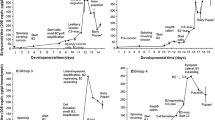Summary
In Tipula oleracea females 2n=6+XX (Diptera) a Feulgen positive body is present in the oogonia and oocyte nuclei. This body appears in the nucleus at the oogonial divisions that precede meiosis. It gets larger by leptotene, attaining a diameter of 6 microns, and at diplotene suddenly disintegrates. By metaphase I the body is not seen.
Injection of tritiated thymidine into the larvae leads to a heavy labelling of the Feulgen positive body. The body is found to synthesize DNA at a different period of time from the chromosomes, and there is an intermediate period when the synthesis of the two nuclear structures overlaps.
The tritium labelled thymidine is released from the body between the third and fourth day of pupal life. At this time the yolk granules in the cytoplasm become particularly conspicuous.
When the body disintegrates the labelled material becomes easily diluted. The volume of the nucleus and of the cytoplasm are sufficiently large to dilute this material in such a way that it easily becomes indistinguishable from background radiation.
Spectrophotometric measurements of the body reveal that it contains four times more DNA per unit area than the chromosomes. The area of the body is 28.3 square microns and that of the chromosomes 78.5 square microns. This means that the amount of DNA in the body is of a higher order of magnitude than that found in all the chromosomes.
This large amount of DNA becomes suddenly available either to the chromosomes or other cellular components. DNA can carry its own genetic information to other cellular components.
Similar content being viewed by others
Literature cited
Bauer, H.: Die Histologie des Ovars von Tipula paludosa Meig. Z. Zool. 143, 53–76 (1932).
—: Die Chromosomen im Soma der Metazoen. Verh. dtsch. Zool. Ges. 1952, 252–268 (1952).
Bayreuther, K.: Extra-chromosomale feulgenpositive Körper (Nukleinkörper) in der Oogenese des Tipuliden. Naturwissenschaften 39, 71 (1952).
—: Die Oogenese der Tipuliden. Chromosoma (Berl.) 7, 508–557 (1956).
Breuer, M. E., and C. Pavan: Behavior of polytene chromosomes of Rhynchosciara angelae at different stages of larval development. Chromosoma (Berl.) 7, 371–386 (1955).
Chance, B., R. Perry, L. Åkerman and B. Thorell: Highly sensitive recording microspectrophotometer. Rev. sci. Instr. 30, 735–741 (1959).
Ficq, A., and C. Pavan: Autoradiography of polytene chromosomes of Rhynchosciara angelae at different stages of larval development. Nature (Lond.) 180, 983–984 (1957).
Gall, J. G., and W. W. Johnson: Is there “Metabolic” DNA in the mouse seminal vesicle? J. biophys. biochem. Cytol. 7, 657–666 (1960).
LaCour, L. F., and S. R. Pelc: The incorporation of tritiated-thymidine in the nuclei of roots of Vicia faba. Proc. Xth Int. Congr. Genetics 2, 156–157 (1958).
Lima-de-Faria, A.: Initiation of DNA synthesis at specific segments in the meiotic chromosomes of Melanoplus. Hereditas (Lund) 47, 674–694 (1961).
Pelc, S. R.: Metabolic activity of DNA as shown by autoradiographs. Lab. Invest. 8, 225–236 (1959).
—, and P. B. Gahan: Incorporation of labelled thymidine in the seminal vesicle of the mouse. Nature (Lond.) 183, 335–336 (1959).
—, and L. F. LaCour: The incorporation of H3-thymidine in newly differentiated nuclei of roots of Vicia faba. Experientia (Basel) 15, 131 (1959).
Rudkin, G. T., and S. L. Corlette: Disproportionate synthesis of DNA in a polytene chromosome region. Proc. nat. Acad. Sci. (Wash.) 43, 964–968 (1957).
Stich, H. F., and J. M. Naylor: Variation of desoxyribonucleic acid content of specific chromosome regions. Exp. Cell. Res. 14, 442–445 (1958).
Author information
Authors and Affiliations
Additional information
This work was supported by a grant from the Swedish Natural Science Research Council.
Rights and permissions
About this article
Cite this article
Lima-de-Faria, A. Metabolic DNA in Tipula oleracea. Chromosoma 13, 47–59 (1962). https://doi.org/10.1007/BF00349619
Received:
Issue Date:
DOI: https://doi.org/10.1007/BF00349619




